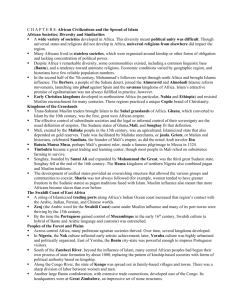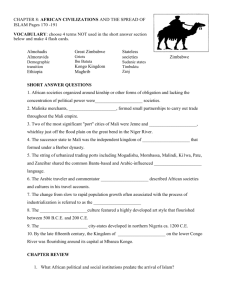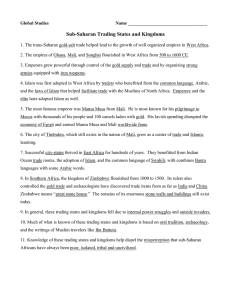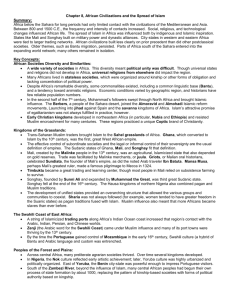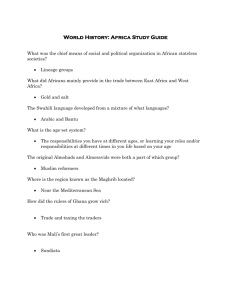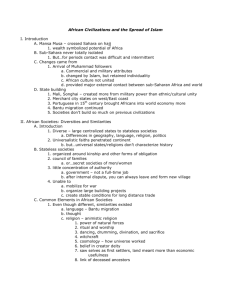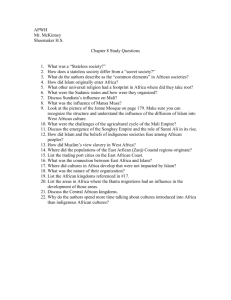Islam in Africa
advertisement
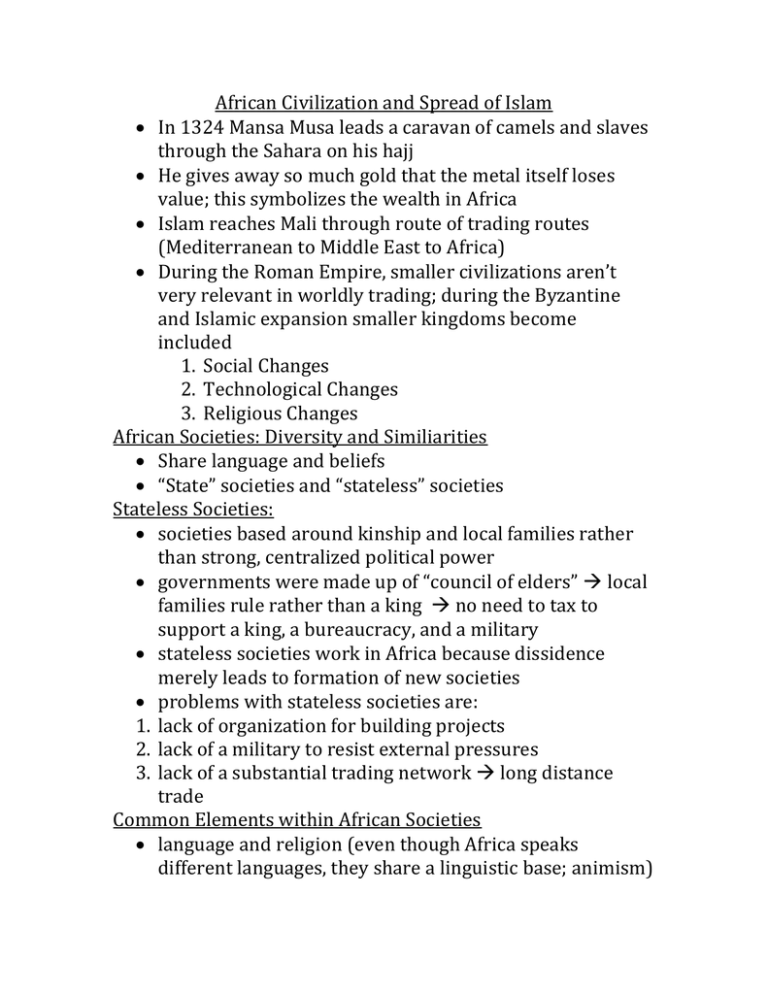
African Civilization and Spread of Islam In 1324 Mansa Musa leads a caravan of camels and slaves through the Sahara on his hajj He gives away so much gold that the metal itself loses value; this symbolizes the wealth in Africa Islam reaches Mali through route of trading routes (Mediterranean to Middle East to Africa) During the Roman Empire, smaller civilizations aren’t very relevant in worldly trading; during the Byzantine and Islamic expansion smaller kingdoms become included 1. Social Changes 2. Technological Changes 3. Religious Changes African Societies: Diversity and Similiarities Share language and beliefs “State” societies and “stateless” societies Stateless Societies: societies based around kinship and local families rather than strong, centralized political power governments were made up of “council of elders” local families rule rather than a king no need to tax to support a king, a bureaucracy, and a military stateless societies work in Africa because dissidence merely leads to formation of new societies problems with stateless societies are: 1. lack of organization for building projects 2. lack of a military to resist external pressures 3. lack of a substantial trading network long distance trade Common Elements within African Societies language and religion (even though Africa speaks different languages, they share a linguistic base; animism) linguistic base is provided by the Bantu peoples animistic beliefs are central to African people worship natural forces as “gods” who need to be worshipped Africans believe in a diety whose power is expressed through “lesser gods” Natural disaster and illness are forms of evil which is produced by witchcraft Overall, religions produced a “cosmology” an understanding of how the universe works that guides ethics and behaviors Northern African economy is different than Sub-Sahara because of trading on the Mediterranean In SS Africa, the staple of their economy lies on trading (local) agriculture Arrival of Islam in North Africa In between 640-700 Muhammad’s followers sweep across North Africa “Ifriqiya” Muslims conquer Spain and move into France but are stopped short of Pyrenees by Charles Martel After the Abbasid dissolution, the “Almohadis” and the “Almoravids” move south into Africa and back into Spain Islam is accepted in Africa there is an idea of all Muslims being equal in the eyes of Allah egalitarianist religion @ the local level, ethnic distinctions divide believers. The fine for killing a man is 2X that of killing a woman. Disparity between Quranic preaching and practical application leads to reformist groups that emphasize Muhammad’s original preachings The Christian Kingdoms: Nubia and Ethiopia (Axum) Christianity has a pretty strong root in Africa as well; Ethiopia and Egypt (coptics) When the Muslim armies conquer Egypt, many Christians keep their faith and establish new kingdoms Kingdoms of the Grasslands: As Islam enters North Africa, it sends merchants throughout the Sahara Merchants spread influences on 3 coasts: 1. Atlantic Ocean 2. Indian Ocean 3. Sahel Sahel is necessary for livelihood of camels; need an arid environment to prevent disease Ghana emerges around 200 CE rise to prominence through trading gold and salt Around 900 Ghana reaches its economic and military height; it falls because 1076 the Almoravids invade and indirectly cause its decline Sudanic States: Sudanic states typically have a patriarch as their leader Have a “core” area ppl with same linguistic or ethnic makeup Most were conquest states; meaning they rely on military support, on taxes, and on tribute Majority of the Sudanic rulers convert to Islam in 900’s Empire of Mali and Sundiata “Lion Prince” Geographically between Senegal and Niger Rivers Mali breaks away from Ghana Mali rulers support Islam through building mosques, attending public prayer, and supporting Islamic preachers Mali’s economic base trade and agriculture Malinke expansion is credited to Sundiata “Lion Prince” revered because he overcomes a bad childhood and unifies N.W. Africa Divides Mali into 16 “clans” Creates loyalty and creates security on trading routes through garrisons important because allows Malinke trading to survive Sundiata’s most famous is successor is Mansa Musa famous for his 1324 hajj which brings Muslim attention to Africa Songhay Kingdom: ?????????
